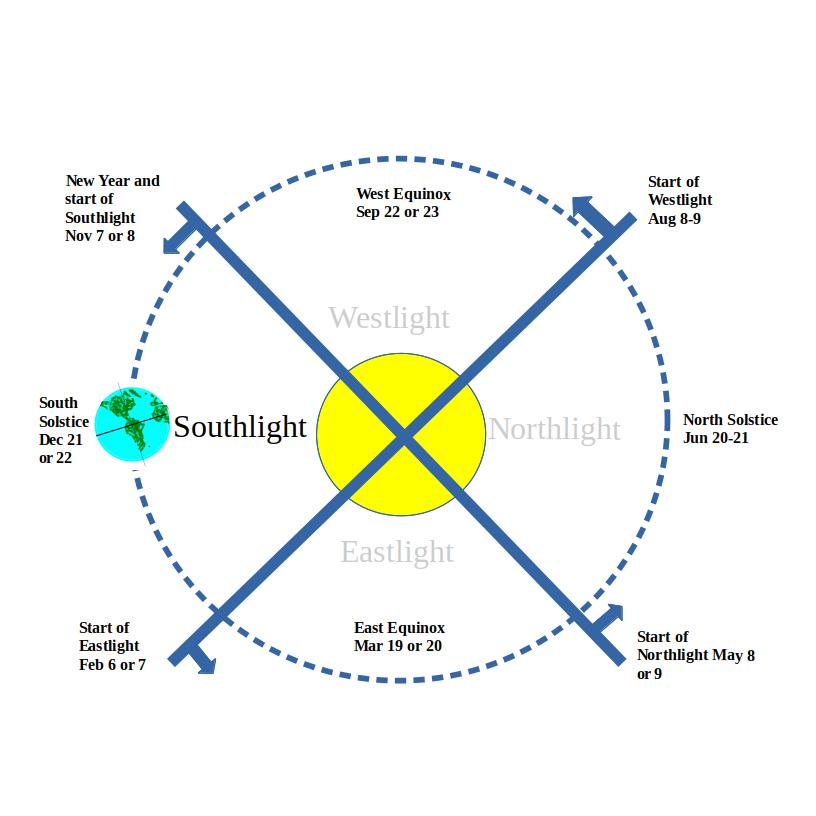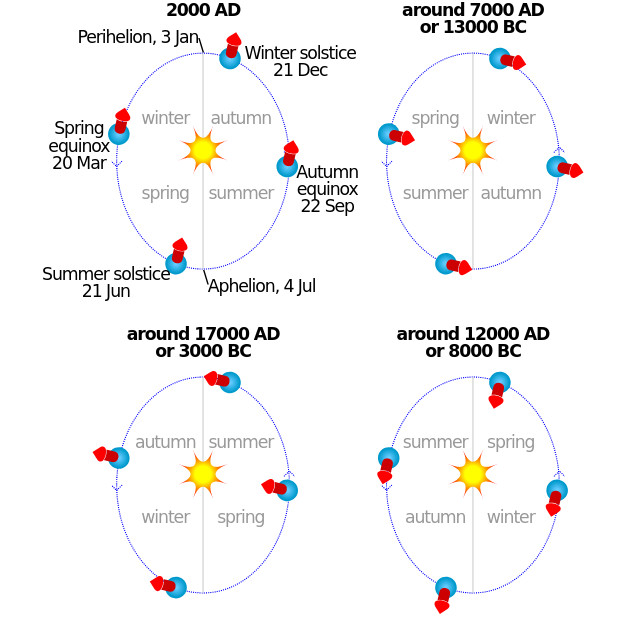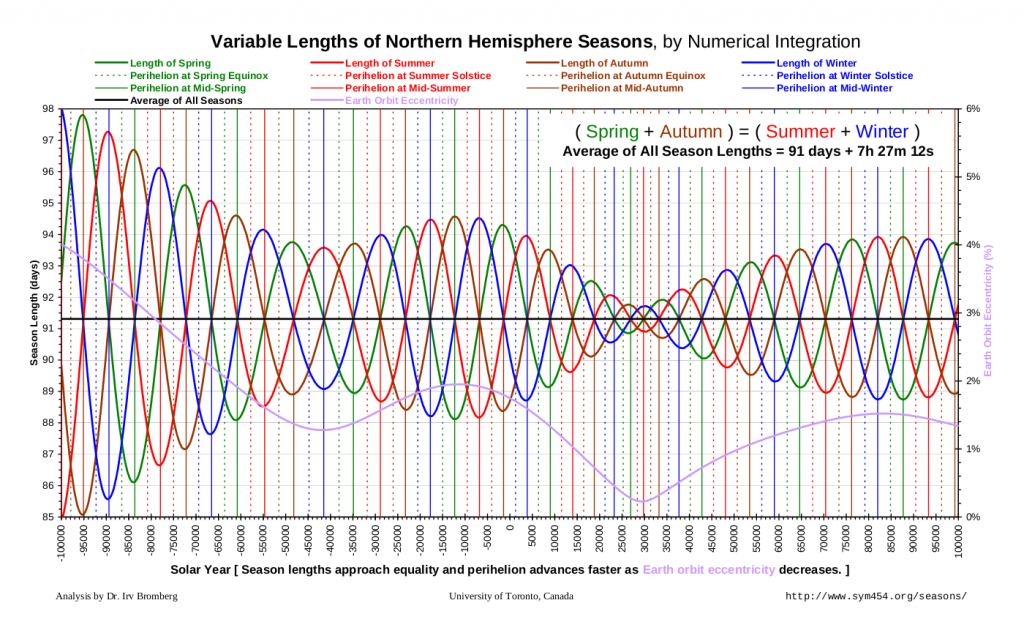| (18.16.12) 11.722 Northlight 85 (9.03 |
Length of quarter: 91-92 days
Rationale
Four quarters are more easily divisible. 91 days x 4 quarters = 364 days. So since most years have 365 days, an extra day is added to the quarter that has the longest “season” of the year. For leap years with 366 days, a second extra day is added to the quarter with the second longest “season” of the year. What this means and how this is done will be explained later.
91 days also exactly equals 13 weeks which means the Day of the week for the first day of the quarter is the same between 91-day quarters. The day of the week moves forward only one day after a 92-day quarter. This takes a lot of guesswork out of what day the following quarter starts.
A lot of human activity divides itself into quarters. A lot of businesses use quarters for planning, or to compare performance between different quarters.
The New Year and the first quarter

Original work–Haven McClure, copyright 2021.
We have already established that the year begins when the Sun is at 15˚ Scorpio. This begins a 91-day quarter around November 7 or 8 (and even occasionally November 6 or 9), and is called Southlight.
The December Solstice is about the halfway point through Southlight. On the December Solstice–which is also known as the South Solstice–the most direct sunlight hitting the Earth is shining on the Tropic of Capricorn at 23.4˚ South.* That day is the shortest and the night is the longest for the Winter Solstice in the Northern Hemisphere, and this is reversed on the other side of the equator for the Summer Solstice in the Southern Hemisphere which is happening at the same time. On either side of the December Solstice in Southlight are 45 days. In the Northern Hemisphere during Southlight, these are (for the most part) the 91 shortest days of the year and in the Southern Hemisphere, these are the 91 longest days of the year.
The other three quarters
So if the new year and the first quarter begin at 15˚Scorpio, does it follow that the second quarter begins at 15˚ Aquarius, since that’s the midpoint between the December Solstice and the March Equinox?
No.
We could do that, but the four quarters of the year would be at different lengths and it would be a challenge to remember what lengths they are. The astronomical position of the quarter between 15˚Scorpio and 15˚ Aquarius represents one-fourth of the planetary plane. But Earth’s rotation is elliptical. That means that the Earth spends a little bit more time in some quarters than in others. The difference in the length of these quarters on Earth can differ by as much as seven days.
Since a calendar is designed to measure time and not distance, we count the days rather than points on a compass. But do make a mental note of the astronomic positions of 15˚ Aquarius, as well as 15˚ Taurus and 15˚ Leo, as they will be used as part of another calculation referencing the above-mentioned “seasons.”
So we count out 91 days, and that takes us to February 6 or 7. Between then and May 8 or 9 is Eastlight. This is the quarter of the year when the most direct sunlight crosses the equator from south to north. In the middle of Eastlight is the Northward Equinox, also known as the Spring Equinox in the Northern Hemisphere and the Autumnal Equinox in the Southern Hemisphere. As the diagram indicates, the “East” doesn’t refer to location, but time. “East” in this calendar refers to the earlier part of the year, just as the sun is in the east in the earlier part of the day.
Between May 8-9 and August 8-9 is Northlight. This is the quarter of the year when the most direct sunlight hitting the Earth is the between the Equator and the Tropic of Cancer. In roughly the middle of Northlight is the North (June) Solstice, which is the Summer Solstice in the Northern Hemisphere and the Winter Solstice is the in the Southern Hemisphere.
Between August 8-9 and 15˚ Scorpio (November 7 or 8) is Westlight—the quarter of the year when the most direct sunlight crosses the equator from the North to the South. In roughly the middle of Westlight is the Southward (September) Equinox, known as the Autumnal Equinox in the Northern Hemisphere and the Spring Equinox in the Southern Hemisphere. And since Westlight is the last quarter of the year, it would be accurate to say that it ends at 15˚Scorpio.
Each quarter has either a solstice or an equinox in the middle of it. The quarters with the solstice end with the suffix “-light” and the quarters with the equinoxes end with the suffix “-crossing.”
Calculating the longest and second longest “seasons”
But this is just one way of determining the seasons.So I said before that the 365th and (if necessary) 366th days would be added to the quarters with the longest seasons and second longest seasons, respectively. What do I mean by seasons?
In much of the Western World, our seasons are Winter, Spring, Summer, and Fall, and they start at the Solstices and Equinoxes, which, astronomically, are 0˚ Capricorn, 0˚ Aries, 0˚ Cancer, and 0˚ Libra. But while these intervals are equivalent astronomically, they aren’t the same number of days. This is because Earth’s orbit is elliptical, and thus our planet spends different amounts of times in each in each quarter. Currently, Winter has 88 days, Spring has 92 days, Summer has 93 days, and Autumn has 89 days. But the relative lengths of these seasons change over time.
Other parts of the world define seasons differently. Some parts of the world have six seasons, such as in the Indian subcontinent.
The Earth Epic Calendar, as well as parts of eastern Asia and medieval northern Europe, (especially with the Celts and Norse) use a Solar timing method based on exposure to the sun, and the beginning of each season is at what Westerners refer to as the “cross-quarters.” This puts the solstices and equinoxes in the middle of the season. The Chinese New Year and the Solar Terms are based on the same methods, though calculating the Chinese New Year is a little bit more complicated. In Ireland, there’s no evidence that the ancient Celts actually ever calculated the cross-quarters, but each of their historical “fire festivals” are about a week before the cross-quarters.
So, while people are free to decide on their own what constitutes a season, the Earth Epic Calendar uses the Solar timing of the seasons. To do this accurately, I use the Swiss Ephemeris, which calculates the planetary positions between 5000 BCE and 3999 CE (4701 EE and 13699 EE). Based on this, the Irish-Asian summer, which is roughly the same as Northlight, is the longest season, and the Irish-Asian autumn,which is roughly the same as Westlight, is the second longest season. So the 365th day of the year is added to the end of Northlight, and the 366th day of the year is added to Westlight.

Why don’t I just specify Northlight and Westlight as the quarters with the leap days instead of referencing “the longest season” and the “second longest season”? Because the longest and second longest seasons are always changing. Back in 1689 CE (11389 EE) the crossquarter autumn surpassed the crossquarter spring as the second longest season of the year. Back in 1952 BCE (7749 EE), maybe a century or so before the reported birth of Abraham, the crossquarter summer surpassed the cross-quarter spring as the longest season of the year. Some time after 4000 CE (13700 EE), the crossquarter autumn will surpass the crossquarter summer as the longest season of the year. The chart above shows how the Earth’s elliptical orbit relates to the seasons, though in this case it’s the equinox/solstice seasons.
Is there a simple way to calculate the cycle of the lengthening and shortening of the seasons? No. The path of Earth’s orbit around the sun is affected by several factors. Both Venus and Jupiter nudge Earth’s orbit a little bit every year. There are also points in time where Earth’s orbit around the becomes less elliptical and nearly circular, or it becomes more elliptical. So even the difference in the lengths of the seasons change, as outlined in this chart below.

So, yes, there are reasonable ways to which we can make this calendar accurate for years to come. Not to mention the fact that the Earth’s rotation is gradually slowing. The earth’s orbit is relatively constant so, with a longer day, at some point we will have to subtract a day from the length of the year. But we won’t have to worry about that for a few hundred million years.
*Not coincidentally, the Earth is currently tilted at 23.4˚ It was at its maximum of 24.5˚ around 8700 BCE (100 EE) and will reach its minimum of 22.1˚ around 11800 CE (23500 EE). The Tropics of Cancer and Capricorn will shift their latitudes accordingly..
—> continue on the Calendar Tour to the Moons page
<— go back to the Year Page
return to the Basic Structure of the Calendar page